Table of Contents
Top 10 Books about OKRs You Must Read
There is a wealth of information available online about the OKR (Objectives and Key Results) framework. Ranging from articles and blogs to promotional information from various OKR software, we have access to a wide range of information. However, the old-school way of gaining in-depth knowledge from books written by industry experts will be a crucial guide for understanding how the OKR tool can be utilised.
In this blog, let’s take a look at the top 10 books about OKRs. We will review some of the most widely-recognised books that discuss OKR strategies and how to set company objectives, drive focus and align employees’ interests to achieve company success.
1. The Beginner’s Guide to OKR by Felipe Castro
https://www.goodreads.com/book/show/40843545-the-beginner-s-guide-to-okr
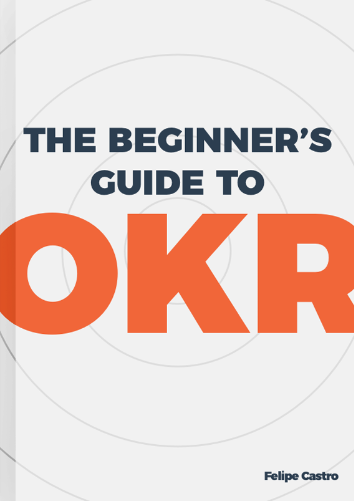

Source – The Beginner’s Guide to OKR
This simple-to-follow beginner’s guide by Felipe Castra serves as a good introduction to those who are keen to learn about the OKR framework. It uses simple language and concepts, acting as a treasure to beginners who can get confused by advanced technical terms usually found in other sources. Within 50 pages, this book covers a wide range of important topics in a straightforward manner. By perusing the book section-by-section, readers can understand how different aspects of OKR can guide companies towards success. It discusses how successful companies like Google, Spotify, Airbnb, and Twitter set goals and succeed. The Beginner’s Guide to OKR contains the following sections-
- What is OKR?
- What are the benefits of using OKR?
- Strategic vs Tactical OKRs: Nested Cadences
- OKRs do not Cascade
- Success Criteria and Types of Key Results
- How ambitious should your OKRs be?
- Creating Alignment
- Tracking Results with the Weekly Check-in
- A Typical OKR Cycle
- Why should you separate OKR and compensation
- Common OKR mistakes
2. Measure What Matters by John Doerr
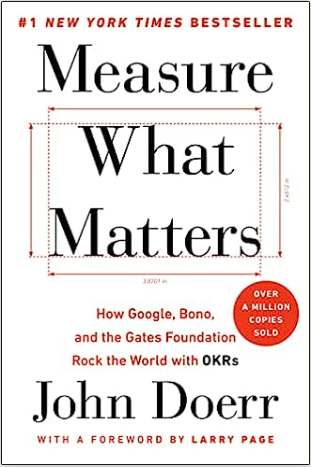

Source – Measure What Matters
American venture capitalist and investor John Doerr is a key player in the development of the OKR framework. Measure What Matters became the #1 New York Times Bestseller for the roadmap it provides to implement OKRs successfully in your businesses. It gives examples through a wide range of case studies that successful people in business like Bill Gates narrate. They discuss how OKRs have brought about focus, stability and growth for organisations worldwide.
The book explores the success stories of Google, Intel and Bono’s ONE campaign. This book is truly informative for anyone looking to optimise their understanding of organisational strategies and performance management.
The book contains the following sections:
Part 1. OKRs in action.
- Google, meet OKRs
- The father of OKRs
- Operation Crush: an Intel story
- Superpower #1: Focus and commit to priorities
- Focus: the remind story
- Commit: the Nuna story
- Superpower #2: Align and connect for teamwork
- Align: The MyFitnessPal story
- Connect: the Intuit story
- Superpower #3: Track for accountability
- Track: the Gates Foundation story
- Superpower #4: Stretch for amazing
- Stretch: The Google Chrome story
- Stretch: The YouTube story
Part 2. The new world of work.
- Continuous performance management: OKRs and CFRs
- Ditching annual performance reviews: The Adobe story
- Baking better every day: the Zume Pizza story
- Culture
- Culture change: the Lumeris story
- Culture change: Bono’s ONE campaign story
- The goals to come.
3. OKRs at the Center by Natalija Hellesoe & Sonja Mewes
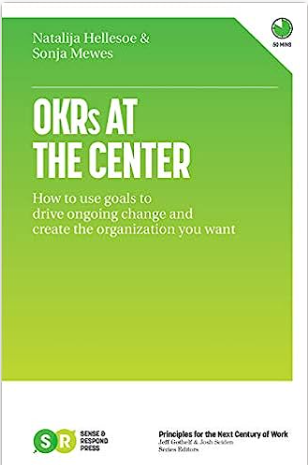

Source – OKRs At The Center
Published in April 2020, this modern book acts as a practical guide that provides tips on implementing OKRs in any organisation. In OKRs at the Center: How to use goals to drive ongoing change in your organisation, readers can learn from both Hellesoe and Mewes’ experience as OKR consultants as they give a step-by-step approach to goal-setting and achieving key results through OKRs. With a comprehensive look at how working with one’s goals can drive change, it shows how new ways of working with aligned goal-setting can profit companies.
This book shows how goals reside at the centre of an organisation system. This can be utilised to reach the maximum potential for organisational development by intentionally adopting the OKR framework. This book is a valuable source for anyone looking to learn or read about implementing OKRs to improve their business potential.
4. Radical Focus: Achieving Your Most Important Goals with Objectives and Key Results by Christina R Wodtke and Marty Cagan.
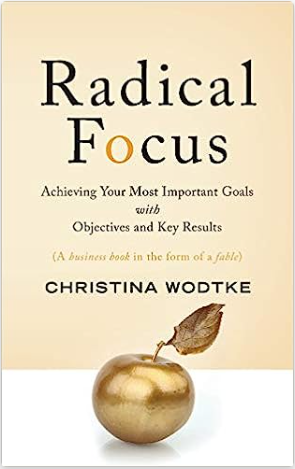

Source – Radical Focus
Radical Focus takes a story-based approach to understanding and implementing OKRs in a business.
The book tells the story of Jack and Hanna’s failing tea startup business and informs the reader about the dos and dont’s of utilising the OKR framework. When their sole investor threatened them with an ultimatum, Jack and Hanna were forced to implement the OKR tool as a last resort to success. Hanna’s experience as a silicon valley professional steers the business to success, thereby showing how goal setting and developing a framework for key results along with regular check-ins can help.
Failure is a necessary step before success, and this book highlights the importance of OKR methodology through this story and provides practical advice.
This engaging and important guide contains the following sections:
Part 1: The Fundamentals of Objectives and Key Results
- Why Objectives and Key Results Matter
- OKR Coaching Example
Part 2: Objectives and Key Results in Practice
- Implementing OKRs for the First Time
- OKRs for Products
- OKRs for Product Teams
- OKRs and the Annual Review
- Score your OKRs
- Credit Where Credit is Due
5. Start Less, Finish More: Building Strategic Agility with Objectives and Key Results by Dan Montgomery
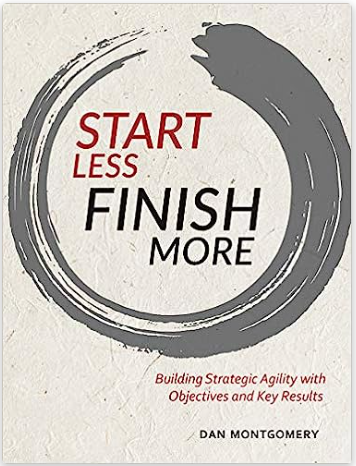

Source – Start Less, Finish More
As the title suggests, every company needs to have a business strategy that is flexible enough to keep up with changes. A stagnant business strategy may fail to maintain itself since it does not automatically adapt to changing work conditions or client demands. A useful, employable strategy is flexible within which the employees and managers are aware of their goals. However, they are also adaptable enough to adjust to any unexpected changes.
Start Less; Finish More guides its readers to use Objectives and Key Results to build strategic agility. This framework can help set attainable objectives and key results and increase overall focus, alignment, and employee engagement.
Montgomery discusses how companies must spend more time working, revising and adapting to their company-wide plan rather than simply wasting their time on preparing their strategic plan. He stresses how companies should start with fewer objectives since it will seem less daunting to start working on them. The book provides practical examples to set OKRs in different industries, thus making it a valuable guide for entrepreneurs.
The eight simple-to-follow chapters include the following:
- Embracing Uncertainty
- Strategy
- Assess
- Focus
- Commit
- Act
- Learn
- Building the Agile Strategy Management Cycle
6. Objectives and Key Results: Driving Focus, Alignment, and Engagement with OKRs by Paul R. Niven and Ben Lamorte
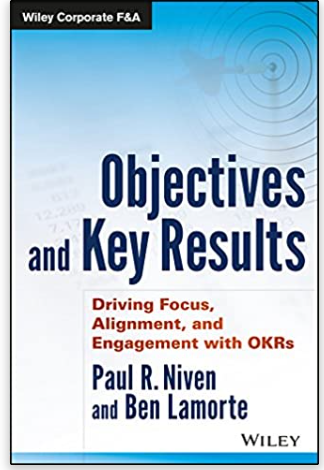

Source – Objectives and Key Results
This book is an advanced-level read that is especially useful for managers. They can use this as a guide to understanding how to align their teams, collaborate with them, and make sure they are on track with company goals. As the title suggests, this book supplies practical tools and guidance to drive focus, enhance alignment, and improve overall communication and engagement within an organisation.
The OKR book Objectives and Key Results: Driving Focus, Alignment, and Engagement with OKRs is divided into seven important chapters-
- Chapter 1: Introduction to OKRs
- Chapter 2: Preparing for Your OKRs Journey
- Chapter 3: Creating Effective OKRs
- Chapter 4: Connecting OKRs to Drive Alignment
- Chapter 5: Managing with OKRs
- Chapter 6: Making OKRs Sustainable
- Chapter 7: Case Studies in OKRs Use
7. How to Measure Anything by Douglas W. Hubbard
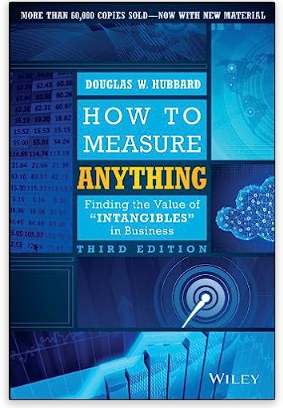

Source – How to Measure Anything
Measurements for better business practices is a critical skill that entrepreneurs, employees and managers need to pick up. Hubbard is an industry expert who explains how managers must be aware of how to make less risky and more economically and strategically profitable decisions. Measuring and quantifying things that matter is crucial for business success. Be it a business, government agency or organisation, any “immeasurable” things such as technology risk, customer satisfaction, technology ROI, and so on can be measured. With different measurement methods, companies can enhance various areas, such as risk management and customer satisfaction.
Through the four important parts of Measurement: The Solution Exists; Before You Measure; Measurement Methods, and Beyond the Basic, the overall content focuses on making technical applications of OKR understandable for those who want to have a deeper understanding of measurable objectives. The book tries to show that “immeasurability” is a misapprehension and that companies can undertake measurement methods for success.
8. High Output Management by Andrew Grove
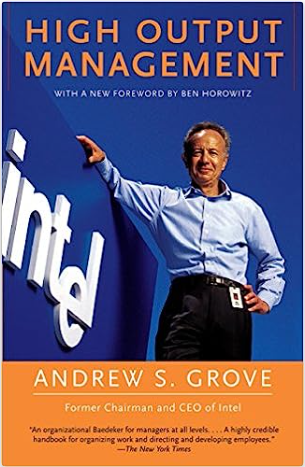

Source – High Output Management
Written by the father of the OKR framework and former CEO of Intel, Grove discusses how the output of a manager is defined by the output of the team members who work under their guidance. He discusses how to build a highly efficient team by designing different methods of motivation that can lead to better performance.
The book is a practical handbook for dealing with real-life business scenarios. It is popular in Silicon Valley since it is also a mini crash course for managers, whose objectives, according to the book, revolve around increasing the output of their team. They must handle meetings, properly delegate, motivate their employees, and hold performance reviews.
The OKR book “High Output Management” is divided into four parts.
Part 1. The breakfast factory
- The basics of production: delivering breakfast
- Managing the breakfast factory
Part 2. Management is a team game
- Managerial leverage
- Meetings: the medium of managerial work
- Decisions, decisions
- Planning: today’s actions for tomorrow’s output
Part 3. Team of teams
- The breakfast factory goes national
- Hybrid organisations
- Dual reporting
- Modes of control
Part 4. The players
- The sports analogy
- Task-relevant maturity
- Performance appraisal: manager as judge and jury
- Two difficult tasks
- Compensation as task-relevant feedback
9. How Google Works by Eric Schmidt and Jonathan Rosenberg
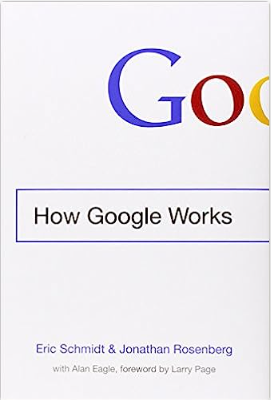

Source – How Google Works
Google is a company that revolutionised the internet and tech world as we know it. This book offers insight into its growth and technological innovation through the usage of OKRs. Its eight chapters discuss the culture, values, and innovations made by Google that made it the industry giant that it is today. They include-
- Introduction – Lessons Learned from the Front Row
- Culture – Believe Your Own Slogans
- Strategy – Your Plan is Wrong
- Talent – Hiring is the Most Important Thing You Do
- Decisions – The True Meaning of Consensus
- Communication – Be a Damn Good Router
- Innovation – Create the Primordial Ooze
- Conclusion – Imagine the Unimaginable
10. The OKRs Field Book: A Step-by-Step Guide for Objectives and Key Results Coaches by Ben Lamorte
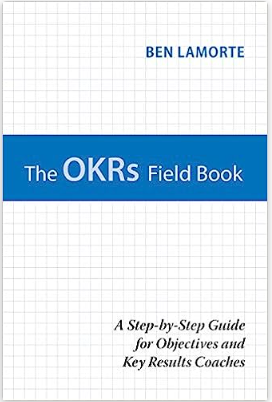

Source – The OKRs Field Book
The OKRs field book is apt for business coaches and mentors who are looking for a scalable structure to assist their clients in reaching their ambitious goals. The book gives a detailed explanation of how to coach teams to set goals and guide them through the phases of doing so. Since the book provides real-life accounts of clients and reminders to overcome obstacles, it acts as a guide to help mentors create their coaching program.
The five chapters of this book include-
- Chapter 1: What is OKRs Coaching?
- Chapter 2: The OKRs Coaching Engagement
- Chapter 3: Playbook for Phase 1: Deployment Coaching
- Chapter 4: Playbook for Phase 2: Training
- Chapter 5: Playbook for Phase 3: Cycle Coaching
Books add a wealth of information, and these books about Objectives and Key Results (OKRs) clarify how to use the tool for success. One can easily gain a sea of knowledge about the benefits of OKRs by perusing them. Written by industry experts, they guide setting goals, tracking progress, and more.
Want to learn more about OKRs for setting goals to scale your business to greater heights? Sign up for free today!



